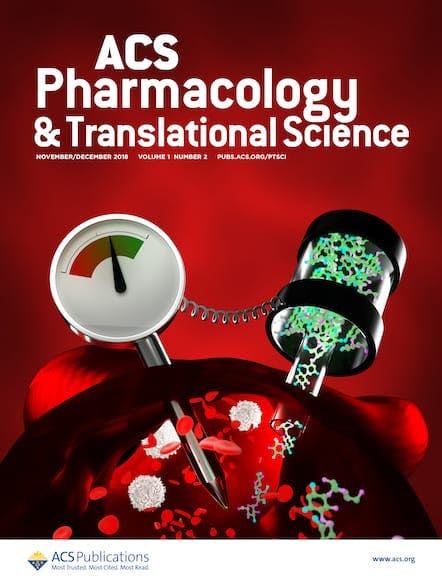An ACS Pharmacology & Translational Science Virtual Issue explores the molecular mechanisms and management of chronic respiratory diseases. The lungs are constantly exposed to a mix of noxious agents present in the air, including particles, chemicals, and infectious organisms.1 Globally, respiratory diseases cause a significant burden and are a leading cause of premature mortality.2 Even […]

An ACS Pharmacology & Translational Science Virtual Issue explores the molecular mechanisms and management of chronic respiratory diseases.
The lungs are constantly exposed to a mix of noxious agents present in the air, including particles, chemicals, and infectious organisms.1 Globally, respiratory diseases cause a significant burden and are a leading cause of premature mortality.2 Even before the COVID-19 pandemic, lower respiratory infections were the leading cause of communicable death—responsible for more than 2 million deaths in 2019 and rising sharply in 2020.2 Despite this, many chronic respiratory conditions are poorly understood, and lack effective disease-modifying therapies.
This Virtual Issue in ACS Pharmacology & Translational Science showcases publications in three categories: SARS-CoV-2 infections, cystic fibrosis, and chronic respiratory diseases—looking at the role of chemistry in pushing the boundaries of basic, translational, and clinical research.3
The Next Generation of COVID-19 Treatments
By now, we are all very familiar with severe acute respiratory syndrome coronavirus-2 (SARS-CoV-2)—the new coronavirus that causes COVID-19 infection and that resulted in a global pandemic being declared in March 2020 by the World Health Organization. The speed at which COVID-19 vaccines were developed was remarkable, but scientists are now tackling the issue of vaccine-resistant variants. One study summarizes how next-generation COVID-19 vaccines can prevent the emergence of these variants by circumventing antigenic drift while defusing viral infections.4
Others are turning their attention to potential drug targets for COVID-19 infections, employing a hybrid in silico approach to build novel inhibitors of multiple variants using both machine learning and pharmacophore-based modeling.5
Several papers examine the dynamic structure–function and structure–free energy relationships of the virus’s main protease (Mpro), with a focus on characterizing the mechanism of action of six novel inhibitors directed against this structure.6,7 When used in combination with traditional antivirals, some of these agents show synergistic activity against SARS-CoV-2 replication.8 There is also a potential role for peptide-based antiviral therapy that blocks the human angiotensin-converting enzyme 2 (hACE2) prior to entry—the connecting point between the virus and the human surface receptor protein.9
New Approaches to Cystic Fibrosis Therapy
Cystic fibrosis is thought to affect at least 160,000 people worldwide, and many—particularly those in low-resource areas—are unable to access proper treatment.10 This Virtual Issue provides a review of preclinical and clinical emerging cystic fibrosis conductance regulators (CFTR modulators), examining their in vitro pharmacology and translation to the clinic.11 This is complemented by a summary of current knowledge about the use of CFTR modulators during pregnancy.12
Looking at Biomarkers for Chronic Respiratory Diseases
Addressing the burden of respiratory diseases requires improved diagnosis as well as treatment. One possibility is in identifying biomarkers for chronic respiratory diseases, such as interleukin (IL)-33 in COPD and asthma, or organoids and lung-on-a-chip in pulmonary fibrosis.13,14
With these recent advances in the field of respiratory diseases, the horizon looks optimistic for several approaches to translate into real-life patient applications.
References
- Wisnivesky J, de-Torres JP. The Global Burden of Pulmonary Diseases: Most Prevalent Problems and Opportunities for Improvement. Annals of Global Health 2019;85(1):1.
- Leading causes of death globally. World Health Organization 2020.
- Virtual Issue: Chronic Conditions Affecting Lungs and Airways. ACS Pharmacol Transl Sci 2022.
- Fernández A. Toward the Next-Generation COVID-19 Vaccines That Circumvent Antigenic Drift while Defusing Viral Infection. ACS Pharmacol Transl Sci 2021;4:1018–1020.
- Jain S, et al. Hybrid In Silico Approach Reveals Novel Inhibitors of Multiple SARS-CoV-2 Variants. ACS Pharmacol Transl Sci 2021;4:1675–1688.
- Wan H, et al. Probing the Dynamic Structure-Function and Structure-Free Energy Relationships of the Coronavirus Main Protease with Biodynamics Theory. ACS Pharmacol Transl Sci 2020;3:1111–1143.
- Ma C, et al. Ebselen, Disulfiram, Carmofur, PX-12, Tideglusib, and Shikonin Are Nonspecific Promiscuous SARS-CoV-2 Main Protease Inhibitors. ACS Pharmacol Transl Sci 2020;3:1265–1277.
- Chen T, et al. Synergistic Inhibition of SARS-CoV-2 Replication Using Disulfiram/Ebselen and Remdesivir. ACS Pharmacol Transl Sci 2021;4:898–907.
- Maiti BK. Potential Role of Peptide-Based Antiviral Therapy Against SARS-CoV-2 Infection. ACS Pharmacol Transl Sci 2020;3:783–785.
- Guo J, et al. Worldwide rates of diagnosis and effective treatment for cystic fibrosis. J Cyst Fibros 2022;21(3):456–462.
- Ghelani DP, Schneider-Futschik EK. Emerging Cystic Fibrosis Transmembrane Conductance Regulator Modulators as New Drugs for Cystic Fibrosis: A Portrait of in Vitro Pharmacology and Clinical Translation. ACS Pharmacol Transl Sci 2020;3:4–10.
- Qiu F, et al. Balance between the Safety of Mother, Fetus, and Newborn Undergoing Cystic Fibrosis Transmembrane Conductance Regulator Treatments during Pregnancy. ACS Pharmacol Transl Sci 2020;3:835–843.
- Donovan C, Hansbro, PM. IL-33 in Chronic Respiratory Disease: From Preclinical to Clinical Studies. ACS Pharmacol Transl Sci 2020;3:56–62.
- Jeong MH, et al. Recent Advances in Molecular Diagnosis of Pulmonary Fibrosis for Precision Medicine. ACS Pharmacol Transl Sci 2022;5:520–538.
